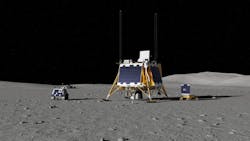Firefly Aerospace to deliver five NASA payloads to Moon’s south pole
Questions and answers:
What is Firefly Aerospace's latest NASA contract for? Firefly Aerospace received a $176.7 million NASA contract to deliver five science and exploration payloads to the Moon’s south pole in 2029 using its Blue Ghost lunar lander and Elytra orbital vehicle.
What payloads will Firefly deliver to the Moon in 2029? The mission will carry two rovers and three instruments, including the MoonRanger rover, a Canadian Space Agency rover, a laser mass spectrometer, a retroreflector array, and stereo cameras to study surface composition, navigation, and lander plume effects.
How will Firefly support lunar communications and imaging? Firefly's Elytra Dark spacecraft will provide communications relay for the Blue Ghost lander and remain in orbit for more than five years to support lunar imaging and mapping through the company’s Ocula service.
CEDAR PARK, Texas - The National Aeronautics and Space Administration (NASA) has awarded Firefly Aerospace in Cedar Park, Texas, a $176.7 million Commercial Lunar Payload Services (CLPS) contract to deliver five payloads to the Moon’s south pole in 2029. The mission will use Firefly’s Elytra orbital vehicle and Blue Ghost lunar lander.
The mission’s objectives include analyzing lunar resources such as water and hydrogen, and studying the Moon’s radiation and thermal environment. These efforts support future astronaut missions and lunar infrastructure development.
Firefly Aerospace’s commercial Blue Ghost lander delivers NASA tech to the moon
Lunar tech
Firefly’s Elytra Dark transfer vehicle will insert the Blue Ghost lander into lunar orbit, where it will provide a communications relay. Blue Ghost will then land at the south pole, deploying two rovers and three scientific instruments. These include:
- The MoonRanger rover, developed by Astrobotic and Carnegie Mellon University, will autonomously explore and map the lunar surface to support resource prospecting and navigation technologies.
- A Canadian Space Agency rover, which will conduct scientific investigations and contribute to understanding the composition and conditions of the Moon’s south pole region.
- The Laser Ablation Ionization Mass Spectrometer (LIMS), which will analyze the chemical makeup of lunar soil to help identify resources such as hydrogen and other volatiles.
- The Laser Retroreflector Array (LRA), designed to assist in lunar surface navigation and geolocation by reflecting laser signals from Earth-based tracking systems.
- The Stereo Cameras for Lunar Plume Surface Studies (SCALPSS), which will record how the lander’s engine plume interacts with the Moon’s surface during descent and landing to inform future vehicle designs.
The lander will provide data, power, and communications support for more than 12 days on the surface.
After completing surface operations, the Elytra Dark spacecraft will remain in lunar orbit for more than five years to support Firefly’s Ocula lunar imaging service. It will join two other Elytra vehicles set to launch in 2026 and 2028, supporting lunar mapping, mission planning, situational awareness, and mineral detection.
About the Author
Jamie Whitney
Senior Editor
Jamie Whitney joined the staff of Military & Aerospace Electronics in 2018 and oversees editorial content and produces news and features for Military & Aerospace Electronics, attends industry events, produces Webcasts, and oversees print production of Military & Aerospace Electronics.
